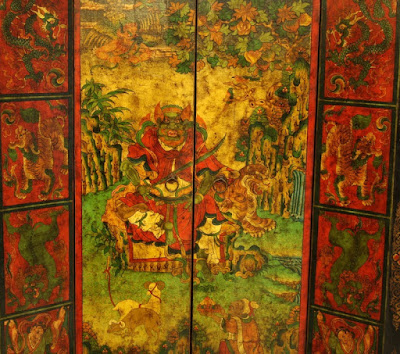Tibetan cabinets
are always colorful. The quality of the painting is dependent on the
ability of the artist, often a monk painter who earns merit as he paints
religious symbols of Tibetan Buddhism on the cabinet's surfaces. The
cabinet is in two parts. The top section has ample storage and can be
converted for storing wine. The interior surfaces are lined with printed
yellow paper of Tibetan prayers and religious symbols. The reason for this
is simple. Many areas of Tibet are in high altitudes above tree lines. In
the lower areas where trees grow, the lumber available for furniture
making is mostly evergreen, such as pine which is not an attractive wood.
So paper is used to beautify the interior surfaces.
This Tibetan cabinet is distinctively different
for having recessed doors to highlight the image of an unusual looking warrior
deity seated at royal ease with right leg bent and left leg pendant with a
tiger at his back. His full beard and large ears made him fierce compounded
with the fact that he holds a long drawn sword. A worshipper pays homage with a
bent knee and holding a plate of offering. The figures are situated against a
pastoral background with lush green trees and ground. The background is set
with craggy rocks and vegetation. A tall tree with green leaves stands at a
corner and Garuda, a bird deity appears at the left corner on the top. His beak
holds a long snake and his claw hands hold it in place. According to a Tibetan
expert, this bearded deity is probably a protector worshipped by people of a
certain local, and he would not be found in the pantheon of Tibetan deities. He
is acknowledged as a princely figure, seated in a princely pose.
The cabinet has
good age and the restorations made it attractive. Details in the architectural
elements that frame the header of the cabinet, and on the bottom section show
everything was hand chiseled. It was said that a prayer went with every wood
square as the carving was performed. These architectural elements are not
unlike the ones in the temples. The paintings everywhere on this particular
cabinet appear to be older than the painting of the pig face warrior on the
doors. It is very possible that original door painting was defaced and needed a
replacement. This cabinet is like a miniature temple, and the original purpose
was storage for religious objects. It is very attractive and should be
appreciated regardless of the alterations. The overall dimensions are 36 inches
wide, 22 inches deep and 84 inches high.








